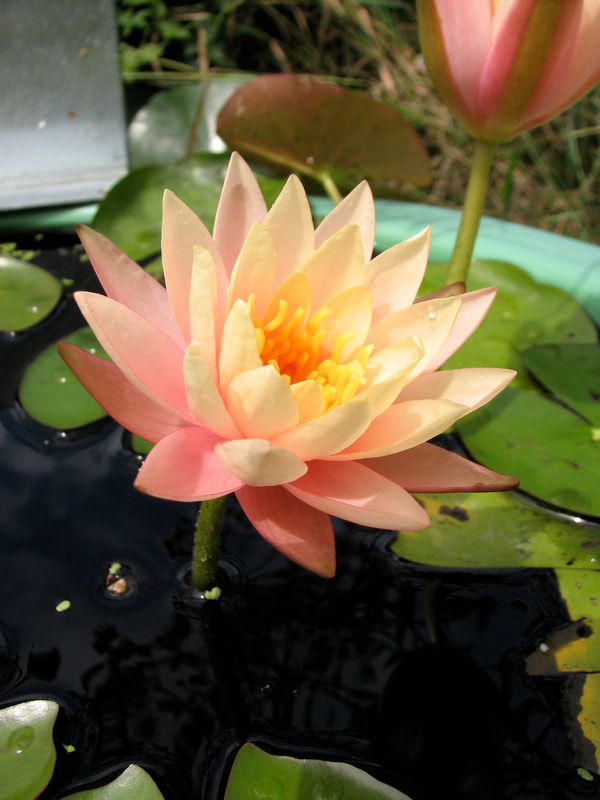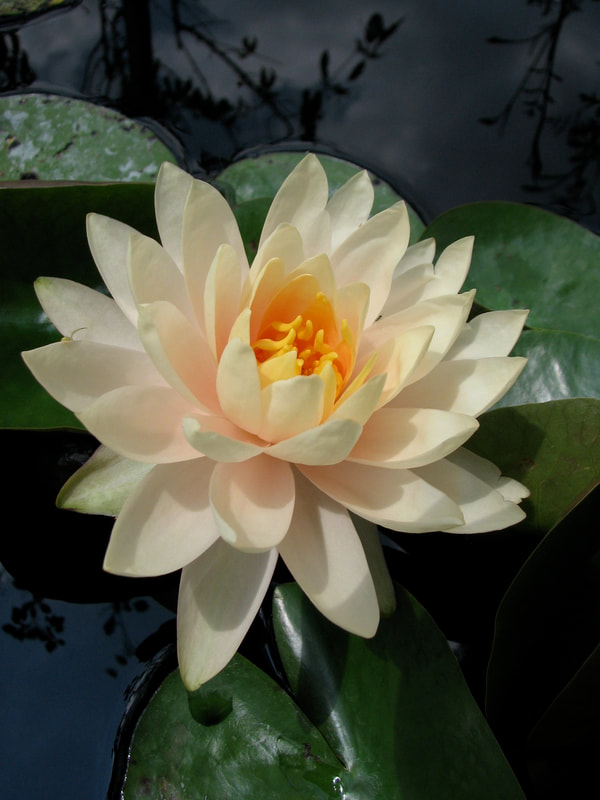Peach Water Lilies
Some of the newest varieties of water lily are a combination of pink and yellow colors that are categorized under a number of names depending on the author - “Sunset” “Salmon” “Orange” and “Peach” are the most common - that variety of color names reflects the fact that the color on most of these lilies really can be hard to pin down.
'Blushing Bride'
I'm simply baffled that this lily is not more popular or commonly available. Great color, great form, it flowers well and has unique, strongly mottled foliage. It's simply Perry Slocum's best peach colored lily. It also has the interesting habit of occasionally not opening its flowers all the way. At first this bothered me, but then I realized the partially open flowers are unique looking and attractive in their own way.
'Clyde Ilkins'
Probably the most prolific bloomer amongst the peach lilies is Kirk Strawn's hybrid 'Clyde Ilkins.' It always seems to have two or three flowers open at one time. The flowers are medium-sized, and the plant is as well, making it a good choice for small to medium ponds.
'Colorado'
This lily ranges more into the pink side of the "peach" spectrum than almost any other lily. You most often see it described as salmon pink. The outer petals tend more to shades of pink and the inner petals more to yellow-orange. The tips of the outer petals also range into yellow-orange. 'Colorado' is a very free flowering lily and it tends to send its flowers up a few inches above the foliage so they are never hidden. Cruise around the web looking for information and reviews of water lilies and you'll find this Kirk Strawn hybrid is a favorite of many.
'Cynthia Ann'
One of the more compact “Peach”-colored lilies. In fact we’ve been growing it in a half-whiskey barrel in the display area of the nursery for many years. It does have a hybrid “odorata” type rhizome though and spreads somewhat rapidly in the small pot that we use in half-whiskey barrels. It probably would be better grown in a small or medium-sized pond or directly in the soil of a natural pond. ‘Cynthia Ann’ is a Kirk Strawn hybrid and, like many of his creations, the flowers are held high above the foliage on strong stems. If you have a shallow pond this can be an advantage because the flowers will not be hidden beneath a pile of foliage.I'd like it to be more free flowering than it is - if it flowered as much as say 'Starbright' this would be one fantastic lily.
'Florida Sunset'
A Perry Slocum introduction, if you're looking for something in more of a pastel shade than the typical peach lily this is a good choice. It's form is its best attribute - very double with wide petals. It's a good flowerer - not in the same class as 'Peachglow' or 'Clyde Ilkins' and probably fewer flowers than 'Blushing Bride', but enough that you're not wondering when the heck that lily is going to flower again. I've thought about removing it from my collection but I've always liked lilies that have a hint of pink in the outer petals, like 'Marliac Carnea' - it gives the flower a unique look.
'Innerlight'
My plant was purchased with the label 'Highlight' and for a couple of years I thought it was that variety. Then I noticed a flower with deep yellow inner petals, which looked more like pictures I had seen of 'Innerlight'. So I did a petal count and came up with 35 which matched Perry Slocum's count in his book for 'Innerlight' (34-36), and which is more than the count for 'Highlight' that Perry provides (26-28). So I'm pretty confident the lily pictured here is 'Innerlight' not 'Highlight'. Like many (most? all?) of Kirk Strawn's peach lilies the color of this variety varies tremendously over the course of the season and perhaps, more proximately, due to the weather - to be honest, I'm not entirely sure what causes so much variation in flower color, but it keeps things interesting as you're always wondering just what color that flower that's about to open is going to be. They vary from almost white with no hint of deeper inner petal color, to white or pale yellow with a hint of peach to pale yellow with yellow inner petals to pale peach.
'Little Sue'
This Kirk Strawn introduction is perhaps the best of the smaller sized, "changeable" lilies. Similar varieties like 'Aurora,' and 'Chrysantha/Graziella,' simply don't flower very well for me. Actually, that's an understatement. They hardly flower at all. What's the point?
'Mangkala Ubol'
Introduced in 1997 by Thai breeder Dr. N. Nopchai Chansipa of Bangphra Technology University, ‘Mangkala Ubol’ won the International Water Garden Society’s Best New Hardy Waterlily for 2004. The flowers are primarily yellow but with enough pink tinge throughout that they appear peach-colored from a distance. Combine this color with a very double flower form and you have a great lily. In fact, I think this is the best peach-colored lily in existence. I've tried to give Perry Slocum's 'Peaches and Cream' a shot at besting 'Mangkala Ubol' but have had doubts I've received a correctly named plant despite purchasing 'Peaches and Cream' from a number of different growers. What I have received pales in comparison to 'Mangkala Ubol' - perhaps I was sent an incorrectly labeled lily or perhaps 'Peaches and Cream' really does pale in comparison with 'Mangkala Ubol.'
'Peace Lily'
I really wanted to like this lily - who wants to dislike a lily named after such a noble concept? But there's nothing remarkable about the lily. The flower isn't particularly colorful, being a somewhat peachy-toned yellow. The flower isn't particular large or multi-petaled. And it's not a prolific flowerer.
'Peach Glow'
When I wrote that 'Clyde Ilkins' is the best flowerer among peach water lilies, I forgot about this variety. 'Peach Glow' is probably slightly more prolific. And it has larger flowers. It's a great plant.
'Pink Grapefruit'
So what's a lily with pink in its name doing over here with the "Peach" lilies, you may be thinking? And compared with the other "Peach" lilies it looks very "pink." Indeed it does. But when I had it over with the "Pink" lilies it looked very "Peachy." And when you pick a color on a picture of this flower with a computer color picker it most often comes out a shade of orange. It's similar to 'Colorado' in that regard - the overall effect is "pinkish" but the underlying colors are shades of orange. Both are Kirk Strawn hybrids and probably closely related. 'Pink Grapefruit' is a bigger plant with a little bit bigger flower than 'Colorado.' I guess the way to think about this is that some varieties of "Peach" water lily are going to be more on the pink side of the spectrum and others are going to be more on the yellow side of the spectrum.
'Siam Sunset'
First flower for us in 2021. This is one of the most intensely colored of the peach-colored lilies. We decided to replace 'Cynthia Ann' in our collection with this lily. While we love the intense color, and the more double form, 'Siam Sunset' doesn't have quite the elegance of 'Cynthia Ann'. We think it's going to be a more prolific flowerer however. Time will tell.
'Starbright'
Just like 'Pink Grapefruit' and 'Colorado' at first glance this lily belongs more with the "Pink" lilies than with the "Peach" lilies. However, it's another Kirk Strawn hybrid that really is composed of shades of orange when you examine it with a computer color picker even though the overall effect is "pinkish."
'Starbright' is perhaps our most free flowering water lily - it really is a flowering machine. It can't rival 'Fabiola' first thing in spring when that variety is likely to have 5 or 6 or more flowers open at the same time. 'Starbright' rarely has more than 2 or 3 flowers open at the same time in our propagating tub (it likely would have more when grown in a large container or in an earthen bottom pond). But, unlike 'Fabiola' which slows down through the summer, 'Starbright' just keeps on cranking out flowers. It will almost never be without at least one flower open, and often have 2 or 3 open all summer long.
I don't often mention foliage in these varietal descriptions - most lilies have quite similar foliage - the foliage of 'Starbright' though deserves mention - I even provide a couple of pictures of just the foliage in the photo "slideshow" below. The foliage is a deep, dark green, heavily mottled in purple. It's by no means entirely unique, but there are few lilies that you really notice how attractive the foliage looks - that's the case with 'Starbright.'
'Starbright' is perhaps our most free flowering water lily - it really is a flowering machine. It can't rival 'Fabiola' first thing in spring when that variety is likely to have 5 or 6 or more flowers open at the same time. 'Starbright' rarely has more than 2 or 3 flowers open at the same time in our propagating tub (it likely would have more when grown in a large container or in an earthen bottom pond). But, unlike 'Fabiola' which slows down through the summer, 'Starbright' just keeps on cranking out flowers. It will almost never be without at least one flower open, and often have 2 or 3 open all summer long.
I don't often mention foliage in these varietal descriptions - most lilies have quite similar foliage - the foliage of 'Starbright' though deserves mention - I even provide a couple of pictures of just the foliage in the photo "slideshow" below. The foliage is a deep, dark green, heavily mottled in purple. It's by no means entirely unique, but there are few lilies that you really notice how attractive the foliage looks - that's the case with 'Starbright.'
'Wanvisa'
A very unique lily found by Dr. N. Nopchai Chansilpa in Thailand. It was growing in a pond of 'Joey Tomocik' and was almost thrown out! The prominent streaks of cream that occur throughout the flower are striking, but even without that streaking this would be considered a great lily - it's the deepest colored of all the peach lilies. Some growers are using 'Wanvisa' as a parent to create new varieties and the streaking has been genetically stable. Look for new varieties of mottled water lilies in other colors in the coming years. The foliage of 'Wanvisa' is also quite ornamental - dark green leaves, heavily mottled in purple to the point that they could actually be described as dark purple leaves lightly mottled in dark green!













